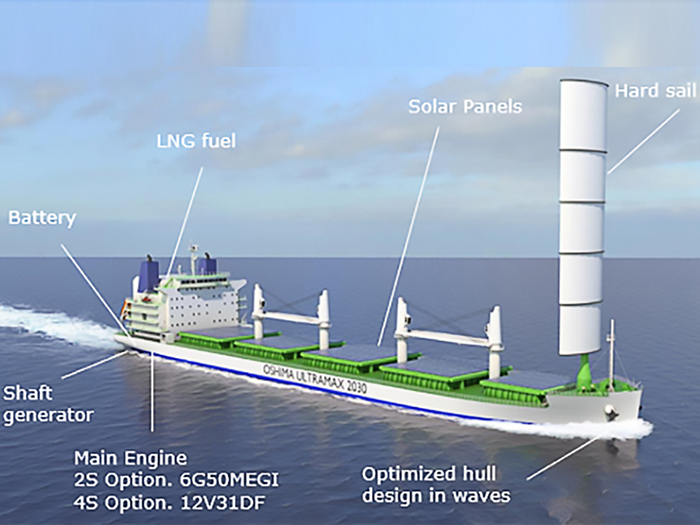
Oshima and DNV GL launch ultra green Ultramax design
Written by Nick Blenkey
New bulker design is claimed to have a 50% better EEDI rating than comparable ships
A new bulk carrier design from Japan’s Oshima Shipbuilding is designed to have a 50% better EEDI (Energy Efficiency Design Index) than comparable vessels. The design, the Oshima Ultramax 2300, is the first to result from a long term strategic cooperation agreement between the shipbuilder and classification society DNV GL set up in response to the IMO strategy to reduce greenhouse gas (GHG) emissions.
The Oshima Ultramax 2030 design maximizes operational performance while minimizing emissions by utilizing LNG as fuel, an optimized hull shape, a sail to generate extra propulsion, as well as solar panels and a battery to cover the hotel load during waiting times and port operations.
The partners aim to continue the strategic cooperation through to 2030, developing and updating a road map towards the IMO zero emissions scenario, which will be gradually implemented through annual joint industry projects (JIPs), where other partners will be invited to join.
“Oshima and DNV GL have already had a close cooperation for many years, resulting in close to 200 ships delivered or on order from Oshima to DNV GL class, and with this strategic agreement we want to extend this cooperation even further,” said Eiichi Hiraga, President of Oshima Shipbuilding. “We are delighted to deliver new, innovative designs together in the years to come.”
“To help the industry meet the ambitious GHG reduction targets set by the IMO, the industry needs to come together to advance ship design, taking advantage of both existing and new technologies,” said Trond Hodne, Director of Sales & Marketing at DNV GL. “This partnership shows how much can come of this approach. The design halves the EEDI of comparable vessels and sets a new standard for low emission bulk carriers. Our relationship with Oshima stretches back many years and we look forward to continue working together in the future.”




